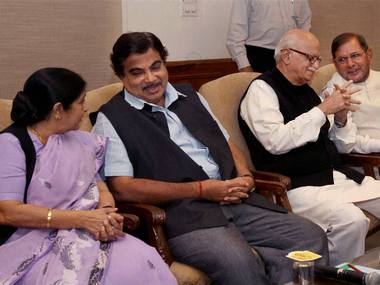The stand-off in parliament with the BJP demanding the resignation of the prime minister and insisting that they will not allow parliament to function till he resigns is caused, simply, by their inability to make friends – and, consequently, bring down the government. Simply put, the BJP is impotent. If you don’t agree, let’s take a look at the composition of UPA 2 below. This lists all those with at least 3 seats in the Lok Sabha and either are officially part of the UPA or support the UPA from outside. Current members in the Lok Sabha 2009 who are part of UPA 2 Indian National Congress - 206 seats All India Trinamool Congress - 19 seats Dravida Munnetra Kazhagam - 18 seats Nationalist Congress Party - 9 seats Rashtriya Lok Dal - 5 seats Jammu & Kashmir National Conference - 3 seats That’s 260 seats. [caption id=“attachment_426717” align=“alignleft” width=“380”]  It might be a good idea to ruminate on why they are such outcasts. PTI[/caption] Parties who support UPA 2 from the outside Samajwadi Party - 23 seats Bahujan Samaj Party - 21 seats Rashtriya Janata Dal - 4 seats Janata Dal (Secular) - 3 seats That’s another 51 seats, making it a 311 member support for UPA 2. The NDA has the following constituents with 3 or more seats BJP –114 Janata Dal (United) – 20 Shiv Sena – 11 Shiromani Akali Dal – 4 That’s a total of 149 seats. Including those who are officially part of the NDA (but with 2 or 1 seat each), the total is 155. Then we have the Third Front, comprising the Left parties, the Biju Janata Dal, AIADMK, etc, with 54 seats. This figure excludes the BSP and the JD (S) who support the UPA from the outside. The Lok Sabha is a 545 member house, with one seat vacant and two nominated members, bringing the strength to 542. What does it take to bring UPA 2 down? In a 542 member house, the magic number to bring the government down is 272 – and the NDA is, therefore 117 seats shy of that. A NDA + Third front would make it 209 seats – leaving a gap of 63. The gap closes dramatically if a single large player, say the BSP or the SP, shifts allegiance. For example, if the SP had to switch camps, the UPA would shrink by 23 seats, coming down to 288 seats and the BJP led opposition would be up to 232. Add the TMC and the opposition would be close to home and dry – the UPA would be at 269 and the opposition up to 251. That’s how precariously this UPA government is perched. Precariously, did I say? The math is simple – but seemingly close to impossible to achieve. Whatever the differences and the lack of love between the Congress and the TMC, Mamata steadfastly supports the UPA when it comes to the crunch. The strangest of bedfellows, the SP and the BSP, natural enemies, both prop up the UPA. If the Congress is allowed to run the country, it’s because of all these parties – the SP, BSP, TMC, DMK, NCP, RJD – find it more useful and profitable to partner with the Congress rather than with the BJP. And till the situation continues, the Congress will be beholden to their partners, looking the other way as, in addition to the centre, there is lack of governance and misgovernance in the states as well. And as far as the BJP is concerned, it might be a good idea to ruminate on why they are such outcasts – almost untouchable – to so many political parties. Because if the next general elections throw up a fractured mandate, as many political observes are certain they will, the BJP will find it more difficult to garner support than the Congress.
If the next general elections throw up a fractured mandate, as many political observes are certain they will, the BJP will find it more difficult to garner support than the Congress.
Anant Rangaswami was, until recently, the editor of Campaign India magazine, of which Anant was also the founding editor. Campaign India is now arguably India's most respected publication in the advertising and media space. Anant has over 20 years experience in media and advertising. He began in Madras, for STAR TV, moving on as Regional Manager, South for Sony’s SET and finally as Chief Manager at BCCL’s Times Television and Times FM. He then moved to advertising, rising to the post of Associate Vice President at TBWA India. Anant then made the leap into journalism, taking over as editor of what is now Campaign India's competitive publication, Impact. Anant teaches regularly and is a prolific blogger and author of Watching from the sidelines. see more


)
)
)
)
)
)
)
)
)



